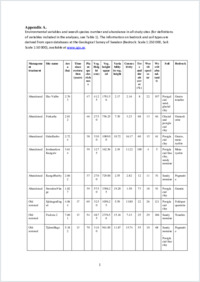Restoration of semi-natural grasslands, a success for phytophagous beetles (Curculionidae)
- Steiner, Magdalena Department of Ecology, Swedish University of Agricultural Sciences, Uppsala, Sweden / Department of Biology, Unit Ecology & Evolution, University of Fribourg, Chemin du Musée 10, 1700, Fribourg, Switzerland
- Öckinger, Erik Department of Ecology, Swedish University of Agricultural Sciences, Uppsala, Sweden
- Karrer, Gerhard Department of Integrative Biology and Biodiversity ResearchUniversity of Natural Resources and Life Sciences Vienna, Austria
- Winsa, Marie Department of Ecology, Swedish University of Agricultural Sciences, Uppsala, Sweden
- Jonsell, Mats Department of Ecology, Swedish University of Agricultural Sciences, Uppsala, Sweden
-
01.12.2016
Published in:
- Biodiversity and Conservation. - 2016, vol. 25, no. 14, p. 3005–3022
English
Semi-natural pastures have rich plant and animal communities of high conservation value which depend on extensive management. As the area of such land decreases, abandoned semi-natural grasslands have been restored to re-establish biodiversity. Restoration schemes, which include thinning of woody plants and reintroduction of grazing, are mainly designed according to the responses of well-studied groups (such as vascular plants and birds). Weevils (Curculionidae) are a very diverse phytophagous beetle family. Here, we evaluated the restoration success of pastures for weevils (Curculionidae), by comparing their species diversity in abandoned, restored, and continuously grazed semi-natural pastures on 24 sites in central Sweden. Weevils were sampled by sweep-netting. We recorded 3019 weevil individuals belonging to 104 species. There was no statistically significant difference in species numbers between the pasture management treatments. However, weevil species composition of abandoned pastures differed from those in restored and continuously managed pastures, but there was no significant difference in community composition between restored and continuously grazed pastures. The abandoned sites tended to be dominated by polyphagous species, whereas the grazed sites contained more monophagous and oligophagous species. The number of weevil species was positively related to understory vegetation height and connectivity to other semi-natural grasslands and negatively related to the cover of trees and shrubs in the pastures. We conclude that restoration of abandoned semi-natural pastures is a good approach to restore weevil communities. To maintain a species rich weevil community, pastures should be managed to be relatively open, but still have patches of tall field- layer vegetation. Restoration and conservation measures should primarily be targeted on regions and landscapes where a high proportion of semi-natural grassland still
- Faculty
- Faculté des sciences et de médecine
- Department
- Département de Biologie
- Language
-
- English
- Classification
- Biological sciences
- License
-
License undefined
- Identifiers
-
- RERO DOC 278442
- DOI 10.1007/s10531-016-1217-4
- Persistent URL
- https://folia.unifr.ch/unifr/documents/305220
Other files
Statistics
Document views: 95
File downloads:
- pdf: 149
- Supplementary material: 134

